- Author: Kathy Keatley Garvey
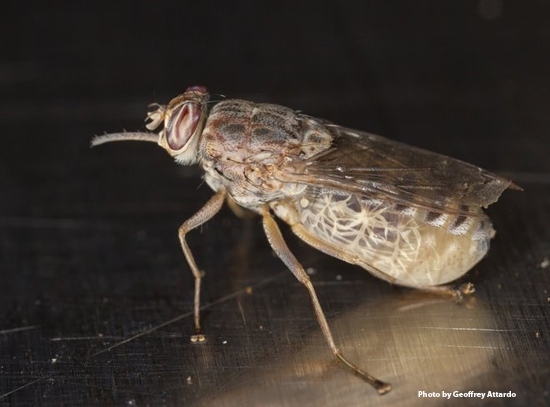
Totally fascinating.
Tsetse fly expert Geoffrey Attardo, a medical entomologist and assistant professor with the UC Davis Department of Entomology and Nematology, drew the attention of Pulitzer-Prize winning science writer Natalie Angier who penned the article, "Everywhere in the Animal Kingdom, Followers of the Milky Way" (subhead: "As scientists learn more about milk's evolution and compositional variations, they are redefining what used to be a signature characteristic of mammals.")
Her lede: "Most female flies take a low-rent approach to parenthood, depositing scores of seed-sized eggs in the trash or on pet scat to hatch, leaving the larvae to fend for themselves."
"Not so the female tsetse fly. She gestates her young internally, one at a time, and gives birth to them live. When each extravagantly pampered offspring pulls free of her uterus after nine days, fly mother and child are pretty much the same size."
Then she quoted the UC Davis medical entomologist:
“It's the equivalent of giving birth to an 18-year-old,” said Geoffrey Attardo, an entomologist who studies tsetse flies at the University of California, Davis.
Attardo focuses his research on numerous aspects of the physiology of tsetse fly reproduction, with the goal to identify and understand key aspects of its reproductive biology. He joined the UC Davis Department of Entomology and Nematology in 2017 from tje Yale University School of Public Health, New Haven, Conn., where he researched tsetse flies in the lab of Serap Aksoy.
In terms of "fascinating physiological adaptations," Attardo considers the tsetse fly "one of the champions of the insect world!" As he explained to us in a 2017 news story: "In addition to being vectors of a deadly disease, Trypanosomiasis, these flies have undergone amazing alterations to their physiology relative to other insects. Some examples of this are their ability feed exclusively on blood, their obligate relationship with a bacterial symbiont, the fact that they lactate and that they give birth to fully developed larval offspring."
"The opportunity to study the adaptations these flies have made is like opening a toy chest for an insect physiologist. My work in tsetse has focused on the molecular biology underlying the adaptations associated with the development of lactation, symbiosis, male and female mating interactions/physiology and nutrient metabolism and mobilization.”
Attardo's published research is drawing national and international attention, as are his incredible images of tsetse flies. He won the 2010 Fogarty Grantee Photo Contest with an image of a tsetse fly. The Yale School of Public Health magazine featured his images on “An Eye for the Tsetse Fly.” The Los Angeles Times published his remarkable video (in 2014) of a tsetse fly giving birth. Also, see his portraits of the tsetse fly on Live Science, published in 2014.
In her New York Times article, Angier points out that "Only in the class Mammalia do all member species nurse their young, yet evolutionary biologists now believe that the roots of mammalian lactation date back more than 300 million years, a good 100 million years before the first mammals appeared."
Who knew?
And while on the subject of tsetse flies, be sure to read the September 2016 article, "Tsetse Flies Are Strange and Dangerous," by Kevin Fitzgerald in Entomology Today, a publication of the Entomological Society of America. Fitzgerald featured the work of Attardo and posted one of his photos.
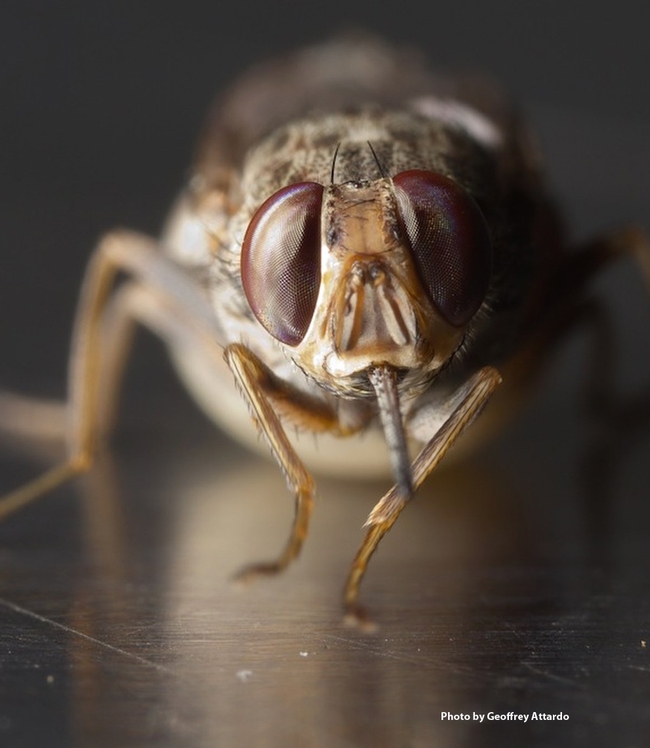

- Author: Kathy Keatley Garvey

They're featured in a recent Entomology Today blog, published by the Entomological Society of America (and written by yours truly) and headlined "Bugs and Beat."
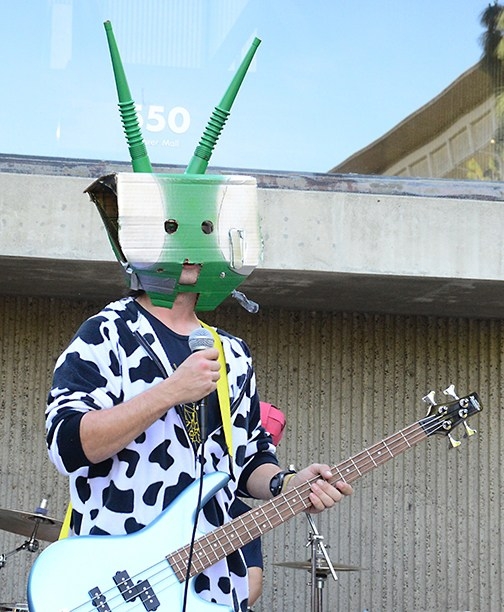
Well, move over. Think about the three-cornered alfalfa hopper (Spissistilus festinus) and the male insect organ, the aedeagus.
A group of seven graduate students in the UC Davis Department of Entomology and Nematology performed such tunes as “E Major Homeboy (Spissistilus festinus),” “Tragedy (of the Clocks),” and “Jackson's Song (Aedeagal Bits),” as well as a cover song, “Island in the Sun” by Weezer. All are members of the UC Davis Entomology Graduate Student Association, headed by Brendon Boudinot, president.
Graduate student Michael Bollinger of the lab of Frank Zalom (a former president of the Entomological Society of America) composed the first three tunes.
The performance capped a day of insect-related activities that included maggot art, cockroach races, nematode identification, scavenger hunts, and honey tasting. Bugs rule!
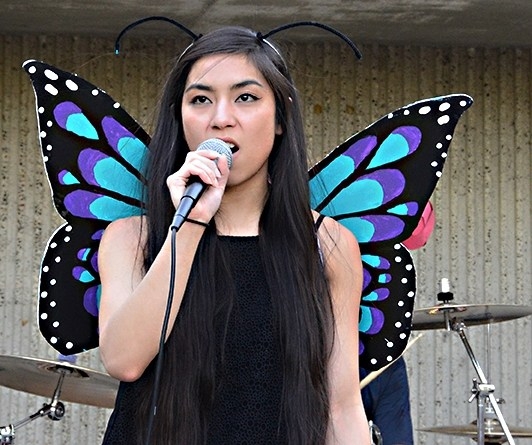
- Molecular geneticist and drummer Yao “Fruit Fly” Cai of the Joanna Chiu lab dressed in a fruit fly costume (Drosophila melanogaster), which he described as “our favorite model organism in Insecta!”
- Bark beetle specialist and rhythm guitarist Jackson “Darth Beetle” Audley of the Steve Seybold lab portrayed an Asian longhorned beetle (Anoplophora glabripennis).
- Honey bee researcher and bass guitarist Wei “Silverfish” Lin of the Brian Johnson lab wore a costume that celebrated his moniker (Lepisma saccharina), a small, wingless insect in the order Zygentoma.
- Ant specialist and keyboard artist Zachary “Leptanilla” Griebenow of the Phil Ward lab dressed as “a generic male leptanilline ant (Formicidae: Leptanillinae).” However, he noted “the yellow color is not anywhere near so vivid in real life.”
- Systematist and tenor saxophonist Jill “Jillus Saximus” Oberski of the Phil Ward lab dressed as a “generalized heteropteran,” which she described as “most likely a member of the family Acanthosomatidae (shield bug) or Pentatomidae (stink bug). My family and friends have called me Jillybug, so I came to be the band's representative of Hemiptera.”
- Molecular geneticist and vocalist Christine “The Clock” Tabuloc of the Joanna Chiu lab wrapped herself in butterfly wings.
- Ant specialist and bass guitarist Brendon “Hype Man-tis” Boudinot of the Phil Ward lab dressed in a green helmet, a blue and gold EGSA bee shirt, and a UC Davis cow costume to showcase his department and campus-wide love of bovines.
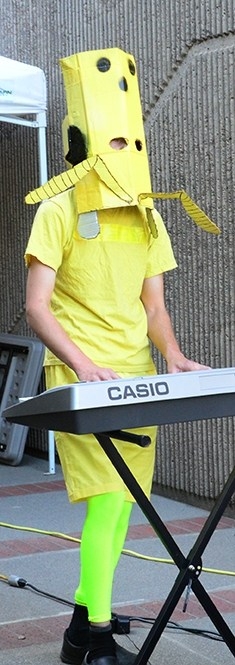
Drummer Yao Cai, who grew up in Southeast China and holds an undergraduate degree in plant protection and a master's degree from China Agricultural University, has been playing drums since age 17. “We formed as a short-lived band for a show. After that, I realized that I really wanted to keep playing and improved my drum techniques. Thus, we started another band in college and played for six years in college, as an undergrad and graduate student.
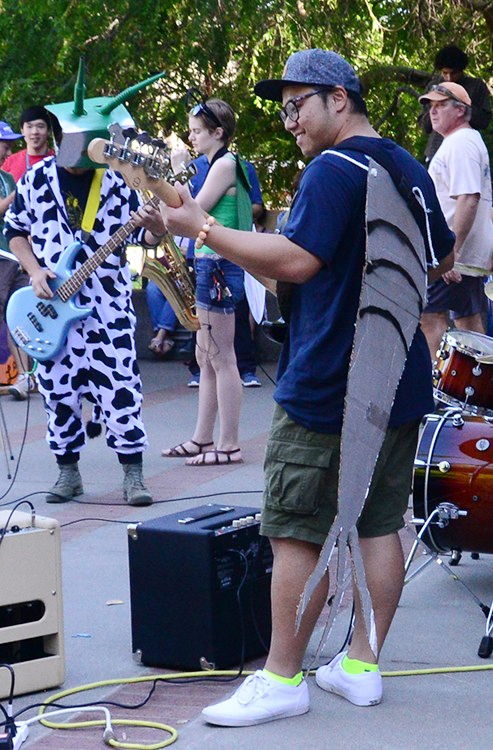
“It is very interesting that I was in a band that was the first band in Department of Entomology in China Agricultural University and now we started the first band in Department of Entomology at UC Davis,” Cai added.
Rhythm guitarist Jackson Audley said he “started learning to play the guitar when I was about 11 or 12-ish. The first band I joined was a Blink-182 cover band, in which I played the bass guitar, and we played together for most of eighth grade. Then in early high school I joined a Smashing Pumpkins/Radiohead cover band as the second guitarist. Shortly after joining that band, we started making predominantly original music. By the end of high school, we had played a few small shows around the Atlanta area and had recorded a few songs. Unfortunately, the band did not survive the transition into university and we broke up.”
Since then he's mostly played “for fun, and I like to jam with folks.”
Jill Oberski, a native of Twin Cities, grew up mostly in Chaska, “a sleepy suburb of Minnesota.” She received her bachelor's degree in Macalester College in Saint Paul, Minnesota, where she double-majored in biology and German studies.
“I started playing the piano in kindergarten and switched to saxophone in fifth grade,” Oberski related. “I played classical and jazz in my school bands from sixth grade through college and pit orchestra, pep band, and marching band in high school as well. I've always been better at classical than rock, jazz, or Latin.”
“I probably reached my highest point in late high school, when I served as co-section leader for the saxes in the Minnesota all-state symphonic band,” Oberski said. “We even got to play a concert in Minneapolis' orchestra hall. These days I'm only involved in the entomology band and some very casual ukulele playing.”

Brendon Boudinot, who received his bachelor's degree in entomology at the Evergreen State College in Olympia, Washington, performed on a metallic sky-blue bass and served as emcee. “I just love art,” said Boudinot, president of the UC Davis EGSA. “Music is a family thing for me in a number of different ways. Although I have played instruments alone or in groups for many years, nothing really clicked in me until I heard Michael and Yao play together. They shred.”
Vocalist Christine Anne Tabuloc, who grew up in the Los Angeles area and received her bachelor's degree from UC Davis in biochemistry and molecular biology, says she does not play an instrument. “I'm far less talented than everyone else in the group,” she quipped. “I've been singing for as long as I can remember. I've been writing lyrics since elementary school. However, I never got around to getting music written for them. I was in choir before and have had solos but that's pretty much it.”
Bass guitarist Wei Lin, who grew up in Xiamen, “a beautiful island in southern China,” received his bachelor's and master's degree at China Agricultural University, majoring in plant protection and entomology. “This was my first experience in a band. I just started to learn bass last year when this band was built.”
Following the four-set gig, Boudinot told the appreciative crowd, “That's all we know!”
Pending performances? “The band,” he said, “is on hiatus.”
Or diapause.
(Editor's Note: Listen to a clips of their music on YouTube.)

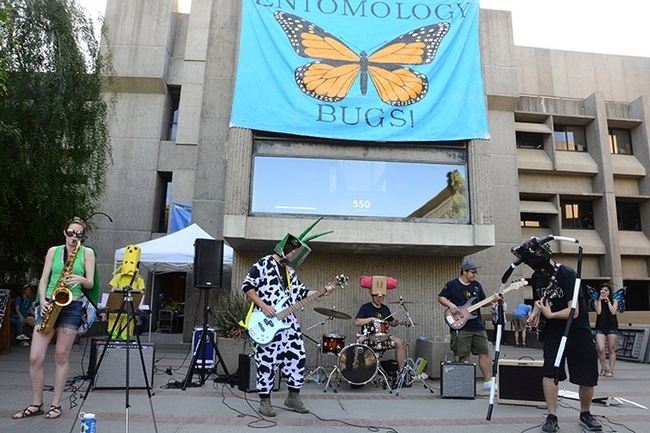

- Author: Kathy Keatley Garvey
Who knew?
You've probably watched those colorful painted ladies (Vanessa cardui) fluttering about in your yard, but have you read the newly published research about their wing color patterns and genetic codes?
In researching the color patterns and the genes responsible for those patterns, biologists Jeffrey Marcus and Roohollah Abbasi of the University of Manitoba, Winnipeg, Canada, found a previously undetected compartment boundary that may exist in all holometabolous insects. (Holometabolism, also called complete metamorphism, is a form of insect development that includes four stages: egg, larva, pupa and adult.)
Scientists have long known that in the common fruit fly, Drosophila melanogaster, the forewing is divided into two developmental compartments, but this newly published research in Scientific Reports, A New A-P Compartment Boundary and Organizer in Holometabolous Insect Wings, is a real eye-opener.
Writer Viviane Callier of Washington, D.C., a trained insect physiologist, wrote about the research in the Nov. 30th edition of Entomology Today, published by the Entomological Society of America.
In her piece, "Butterfly Color Patterns Reveal Clues About the Genes that Build Insect Wings," Callier described butterfly wings as "natural canvases decorated with elaborate color patterns," but noted that "how these patterns develop and evolve is still incompletely understood. Now, a new study in Scientific Reports (Nature.com) has identified the genetic code by which butterflies can assign color patterns to different parts of their wings during development. The code is based on a set of genes called transcription factors that establish compartments in most—perhaps all—insect wings. Each compartment, whose 'address' is determined by the combination of genes that are active in that sector of the wing, can evolve different color patterns independently from the other compartments."
Marcus and Abbasi explained in their abstract:
"Decades of research on the highly modified wings of Drosophila melanogaster has suggested that insect wings are divided into two Anterior-Posterior (A-P) compartments separated by an axis of symmetry. This axis of symmetry is created by a developmental organizer that establishes symmetrical patterns of gene expression that in turn pattern the A-P axis of the wing. Butterflies possess more typical insect wings and butterfly wing colour patterns provide many landmarks for studies of wing structure and development. Using eyespot colour pattern variation in Vanessa butterflies, here we show an additional A-P axis of symmetry running between wing sectors 3 and 4. Boundaries of Drosophila mitotic clones suggest the existence of a previously undetected Far-Posterior (F-P) compartment boundary that coincides with this additional A-P axis. A similar compartment boundary is evident in butterfly mosaic gynandromorphs. We suggest that this additional compartment boundary and its associated developmental organizer create an axis of wing colour pattern symmetry and a gene expression-based combinatorial code, permitting each insect wing compartment to acquire a unique identity and allowing for the individuation of butterfly eyespots."
The research "bears on some of our T-shock experiments back in the 70s-80s," observed Art Shapiro, distinguished professor of evolution and ecology when asked if he'd read the research paper. Yes. He wrote a chapter, The Genetics of Seasonal Polyphenism and the Evolution of 'General Purpose Genotypes' in Butterflies' in the Klaus Wöhrmann/Volker Loeschcke book, Population Biology and Evolution. You can read it online.
In his abstract, Shapiro, who has studied and monitored butterflies for more than four decades and maintains a website, Art's Butterfly World, points out that his Genetics of Seasonal Polyphenism chapter "is really a specialized appendix to Professor Scharloo's on 'The Genetics of Adaptive Reactions.' It deals with a particular set of such reactions — those of butterfly wing patterns to environmental factors — and asks whether those which seem adaptive are evolutionarily related to those which do not, and if so, how. Despite more than a century of interest in such phenomena, the answers are not yet in; we are only now able to do the carefully controlled experiments necessary to partition phenotypic variation into its environmental and genetic components and this work is still very much in progress. So this will be a very unsatisfying presentation — full of qualitative statements, long on speculation, short on hard data. If it serves as a provocation it will have done its duty."
Shapiro goes on to say that "a glance through any butterfly book of the coffee table variety reveals an astonishing diversity of patterns. The fact is that we have only the remotest idea of the functional significance of any of them, as we were recently reminded by Silberglied et al. (1980). One reason is that bewildering diversity which defies rational classification; another is that it is almost impossible to relate a pattern to an ecological and behavioral context when observing a specimen set on a pin."
All the more reason to marvel at the stunning diversity of butterflies that grace our yards. Or what Viviane Callier so eloquently described as "natural canvases decorated with elaborate color patterns."
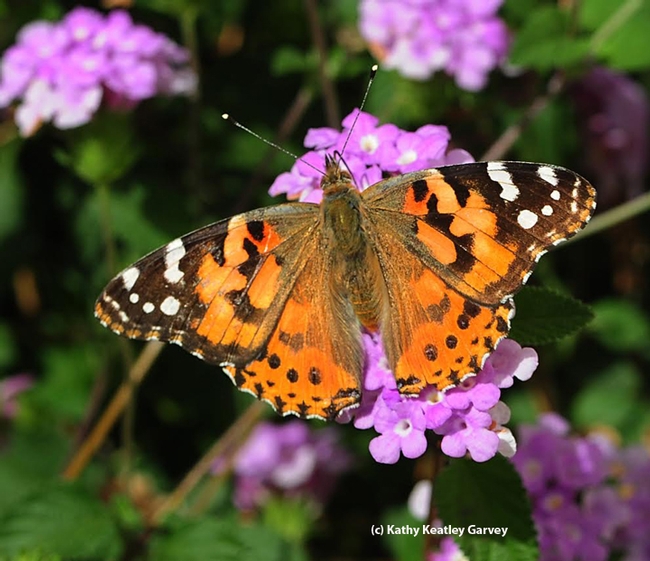
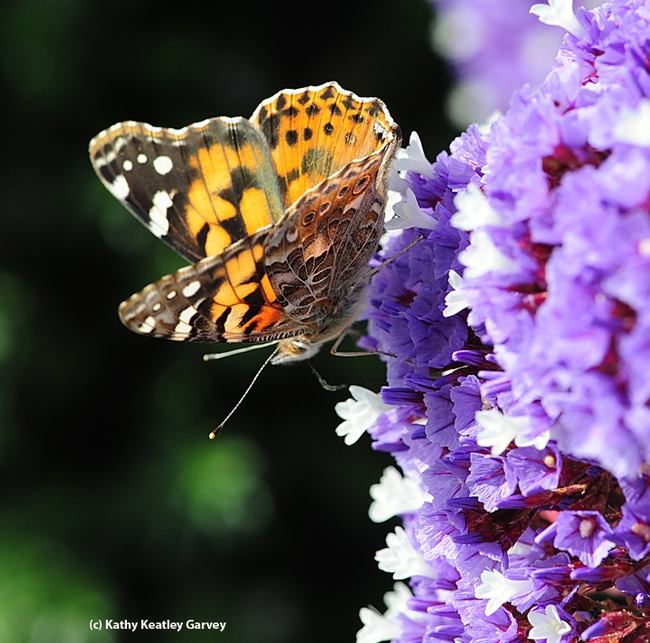
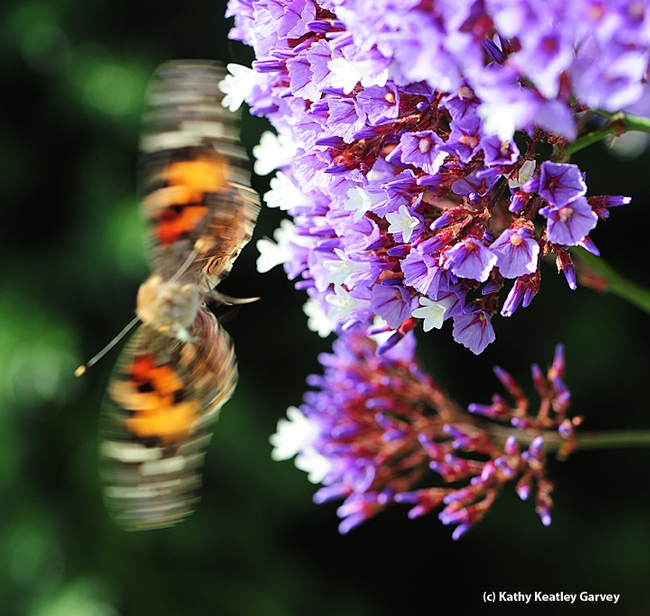
- Author: Kathy Keatley Garvey
Yes, it happens.
We've heard the stories and read some of the scientific literature about what a female praying mantis will do to her partner during the mating process. Sexual cannibalism. She'll bite the head off of her mate and eat it--but the mating process continues unabated. (Except the male has lost his head )
We spotted a mating pair of mantids in our bee garden on Saturday. It was early evening, around 7. They were hidden among the long strands of English lavender.
My camera caught a quick shot of the pair. Yes, two heads. The next picture I took was of the male minus his head. He "lived"--that is, moved around, for about eight hours before expiring. Or, as Lynn Kimsey, director of the Bohart Museum of Entomology and professor of entomology at the University of California, Davis, says: "It will live until it dries up."
Entomology Today weighed in on the sexual cannibalism behavior in its Dec. 22, 2013 edition.
"An urban legend about female praying mantises always eating males during or after mating has circulated for a long time. However, reality is much more complicated.
"Kyle Hurley, an entomology student from the University of Central Arkansas, spent two years observing praying mantises in the lab and made some startling observations. For example, in one out of 45 cases the male actually consumed the female. And in one out of 45 cases, the female removed the head of the male before mating (the males were still able to finish the job)."
Marianne Shockley Robinette, an entomologist at the University of Georgia, was quoted as saying in Entomology Today: "While it has been observed in artificial settings such as laboratories where they're rearing praying mantises, it's rarely been observed in a natural environment.”
Even Snopes, known for debunking urban legends, weighed in on this.
"Yes, the female praying mantis does sometimes eat her mate. In fact, male mantises will often offer themselves up as food to the female during the mating process, and from a biological standpoint this action makes sense: There's no point to mating with a female who might die from a lack of food before she can lay her eggs and pass the father's genes onto the next generation. This doesn't happen all the time, however, and its frequency of occurrence and the reasons for it are still a subject a debate within the entomological world."
The clincher is a YouTube video which clearly shows a female decapitating her mate. If this kind of thing makes you squeamish or queasy, you probably shouldn't watch it. (At least before breakfast.)
But yes, it happens. Nature is not always nice.
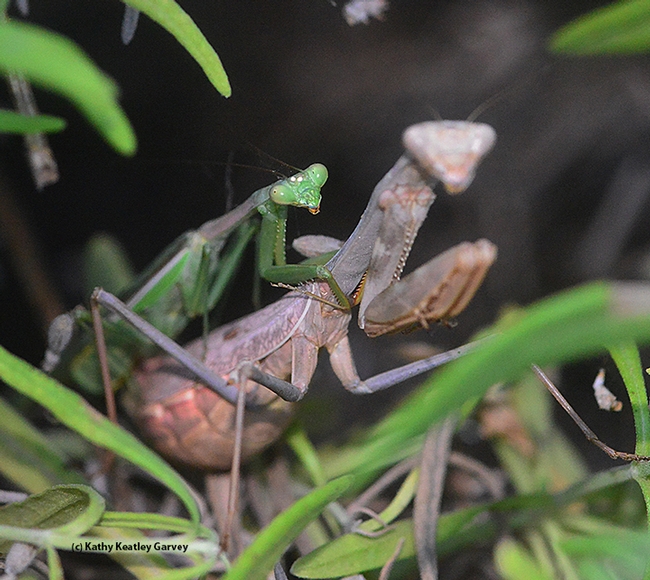
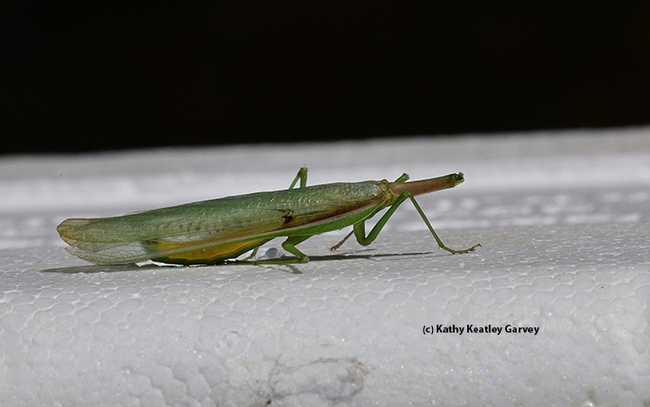
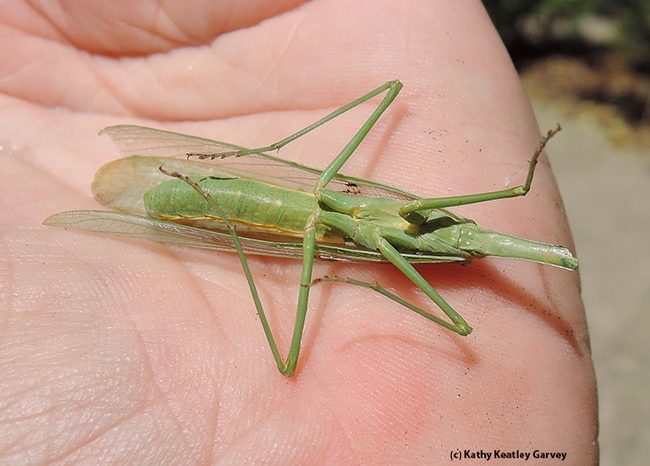
- Author: Kathy Keatley Garvey
Why is that in a honey bee colony, workers can carry pollen but not the queen?
Well, scientists from Michigan State University and Wayne State University have discovered the answer.
They've isolated the gene that's responsible for leg and wing development, according to a news brief in Entomology Today, published by the Entomological Society of America (ESA). The 7000-member ESA, by the way, is headed by president Frank Zalom, integrated pest management specialist and professor of entomology at UC Davis.
The scientists' bee research is published in the current edition of Biology Letters.
“This gene is critical in making the hind legs of workers distinct so they have the physical features necessary to carry pollen,” said MSU entomologist Zachary Huang. “Other studies have shed some light on this gene's role in this realm, but our team examined in great detail how the modifications take place.”
"The gene in question is Ultrabithorax, or Ubx. Specifically, the gene allows workers to develop a smooth spot on their hind legs that hosts their pollen baskets. On another part of their legs, the gene promotes the formation of 11 neatly spaced bristles, a section known as the 'pollen comb.' The gene also promotes the development of a pollen press, a protrusion also found on hind legs, that helps pack and transport pollen back to the hive."
What the research team did was to isolate and silence Ubx, the target gene. "This made the pollen baskets, specialized leg features used to collect and transport pollen, completely disappear," Entomology Today reported. "It also inhibited the growth of pollen combs and reduced the size of pollen presses."
The scientists acknowledge that this won't provide a solution to Colony Collapse Disorder (CCD). They think, however, that their research could lead to bees becoming better pollinators; they could carry larger pollen loads.
Speaking of loads, have you ever seen a bee so heavy with pollen that you wonder if she can lift off? It seems somewhat like a human being weighted down with a bowling ball.
The next time you observe a bee foraging, check out the pollen load. If you're lucky, you'll see the bee packing the pollen, adjusting the load before she buzzes off back to her colony.




